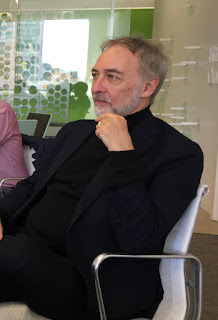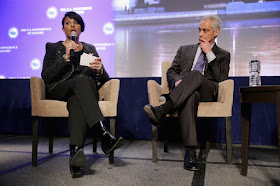So many candidates, so many ideas and still so much confusion! In Sunday's
column Dan Rodricks rightly praises how earnestly the candidates cataloged their programs and position papers, of which we have only seen the beginning. Detailed discussions about the problems and the possible solutions are impressive, from workforce development to community land trusts, from enforcing inclusionary zoning to better managed public housing, better transportation, more audits and certainly a more effective but responsible police force. But it is easy to get the positions confused, they are so similar.
Who has the compelling story, the convincing narrative arc, the long view, the big picture and an idea about Baltimore's future? Who has the ability for putting the puzzle pieces together so that competence, imagination, trust, integrity and energy flow together in the one person that should lead the city to the heights it deserves and needs?
 |
| So much promise (photo: ArchPlan) |
Who tells us that it is Baltimore's destiny to become a successful example of a prosperous and flourishing post-industrial American city? Or that the current state of low expectations should be considered a major screw-up instead of a state of normal?
Certainly Baltimore has a first class location, deep port, DC as a neighbor, growing region and all; there is nothing wrong with the devotion that most area residents have for their city, there is nothing wrong with the quality of our major universities, with the beauty of our architecture, the diversity of our people. In short, there is nothing that condemns Baltimore to be in a bad place. To the contrary, we have the natural, men-made and social assets and we have tons of hard working people, organizations and individual success stories.
What is lacking is the creative assembly of those pieces into a larger Baltimore story. "Bright Future Baltimore". What is lacking is the self-confidence and the certainty that Baltimore can set examples for others instead of eternally being late in copying others.
Living:
As I have said many times, to attract the 25,000 or so additional households that are needed to fill this city back up and eliminate systemic vacancy in its entirety is not as overwhelming a task as it seems. Consider that this city is the center of a region that grows by hundreds of thousands people in the next decade or two. We need the aspiration to speak about rehabilitation, revitalization and rebuilding instead of demolition. Growth instead of shrinkage! Filled and restored houses instead of weedy lots. We need to work as a region to curb the disastrous sprawl to grow the core again. Subsidizing sprawl development with new infrastructure at the periphery and at the same time subsidizing demolition of Baltimore houses at the core (where infrastructure is in in place) is sheer foolishness. New Yprk constructs new micro-apartments. Our micro-units are the 12' alley houses!
As I described in a previous article, the Central Baltimore Partnership created and filled nearly a thousand new units in its ten 20,000 resident neighborhoods in three years. They filled vacants at a rapid clip even in distressed areas thanks to carefully calibrated strategies and qualified partners such as TRF, Telesis, Seawall and, yes, the Vacants to Value program of Baltimore Housing. A new Mayor doesn't have to start from scratch, just expand what already works to new areas such as Park Heights where the groundwork is already prepared and a funding stream secured (Casino money).
 |
| New and old: Greenmount West (photo: ArchPlan) |
Work and Innovation:
Mayors don't really create jobs except in the municipal workforce. But still, they need an idea about where residents should find work. It is currently popular to talk about how people from the city can or can't reach those low-paying jobs sprawling at the periphery of urban centers. Too much talent and creativity is sitting idle in this city, a huge reservoir that must be tapped. Community development organizations and community trusts training re-entry residents to rehab houses or do deconstruction for recycling of materials is an example. Liabilities turned into opportunities:Connecting the underground economy with the above ground economy: decriminalization on a broad front, drugs, music, performance, dirt bikes, hacks, shadow home and car repairs, clothing sales from the back of trucks, the whole bit. No candidate talks about how to give the newly-minted "Innovation Village" in West Baltimore some real meaning or what a "Smart City Baltimore" could look like. Or sustainability: The Planning Department has some real good sustainability strategies and policies ranging from stomwater to urban farms and food insecurity: How would these policies get carried forth?
Those low-paying suburban jobs on the periphery won't be around much longer, they will be replaced by robots. What will work look like in the future and what future industries could allocate in Baltimore? How could mayoral policies assist in creating certain industry clusters, of say, robotics, genomics, 3-D maker spaces and so forth? Only non-profits like the Deutsch Foundation or some researchers at Johns Hopkins seem to care about this, while Mayors always talk about jobs as if the term would mean the same forever.
Culture:
Reaching out instead of withdrawing, realizing that the City is a source of more than just "high culture"; The assurance that engaging everyone is better than segregation, separation and hostility; Adopting the best from all the different cultures and run with it; Taking arts and culture and fuse them in the manner the Baltimore School for the Arts and MICA are demonstrating it; Bridging the cultural divide between black and white in Baltimore, learning from each other, instead of avoiding each other; Emphasizing African American arts and entertainment in the Bromo district and connecting Pennsylvania Avenue into it; Accepting popular expressions by turning the "no cruising signs" into parades on "the Avenue", making the Highway to Nowhere into a dirtbike parcours one night a month. All those should be must do principles. Who knows, we may have the most creative people in America, so much talent uncovered!
Learning:
As Detroit can teach us, being bottom often harbors opportunity. Schools are not only failing in Baltimore but across the US and the world because learning happens increasingly lifelong and beyond the walls of schools. learning can't any longer be cloistered in those buildings for 12 long years and then end. "Open schools" needs to be more than a buzzword. Which city could be better positioned to show what 21st century communities of learning look like than Baltimore where so many traditional schools are obsolete and many traditional learning environments defunct? Putting learning and the school into the community and the community into the school. Baltimore has established many new innovative experiments already which are way more interesting than the question who appoints the school board. Plus Baltimore has the high performing institutions to support new learning concepts with research and networks.
 |
| (photo: ArchPlan) |
Transportation:
A local bike share with innovative e-assisted bikes and a company that will headquarter in Baltimore to organize it is a good start. But why not extend this approach and invent new forms of car sharing as well? Have a local community based version of Uber replacing the widespread system of illegal "hacks"? A pool of non-profit or muni-cars, similar to the corporate model GM is considering to do with Lyft but community and not corporate based?
Can Baltimore outperform Houston when it comes to a radical reform of how buses are deployed in this city? Can riders, neighborhoods, employers, the City, the County and non-profits engage with MTA to make this a success? Can the additional operators needed to drive the buses come from within the communities in need, can non-profits provide the training needed to overcome gaps? Can Baltimore become a city in which an experimental innovation district bans any cars that are not self-driven to see what it takes to make this work and how cities could profit from the revolution of autonomous cars, buses and trucks? The City's application for the federal challenge grant did not get shortlisted. What will the next mayor do to make the applications more competitive? And which mayor will promise to work on getting the Red Line back when the time is right?
 |
Mural on the side of the Arch Social Club
(photo: ArchPlan) |
It isn't my intent to pretend I could provide any cohesive program here, I am just asking questions. This is simply an attempt of providing examples for how much bigger the ideas could be and on how a hopeful story could emerge. Our aspiration for Baltimore should exceed those of Nashville, Chattanooga, Charlotte or Buffalo, We should be aspiring for nothing less than being not only a come-back but a future-city that shows America and the world the outline of a post-industrial but even a "post work" city and how to overcome entrenched poverty so that the zip code no longer defines someone's future. Baltimore must become a city that won't settle with just muddling through, recycling old ideas of the past. Low expectations have been Baltimore's largest enemy for way too long!

I dream that one of the candidates would connect all these dots, and all their own good program ideas to a bigger and louder message, one that resonates not only with those that are already here but with people across the country or around the world. A message that makes one candidate stand out. The yearning for that message is certainly there. For this City to find itself it also needs to find a new place in the nation.
It took me decades to grasp this all-American idealistic concept and not dismiss it as naive. The concept that strong will, a clearly defined goal, and conviction can move mountains. But I have been here long enough now to have seen it work, not necessarily always in good ways.
This concept has worked from Station North to Highlandtown, from the School for the Arts to the Design School, from the Sylvan Learning Center to Under Armour, from Thibault Mannekin's Seawall to Toby Bozzutto, from Christian Siriano to Jada Pinkett and from Ta-Nahesi Coates to D Watkins. It has worked for my own children. It has worked for the many more who remained less famed and often succeeded against all odds. They all set their eyes on the mountaintop, never quit and eventually did what seemed impossible.
In spite of the prevailing political discourse and all the talk about decline, the time to big big and aim high has never been better.
Klaus Philipsen, FAIA









































